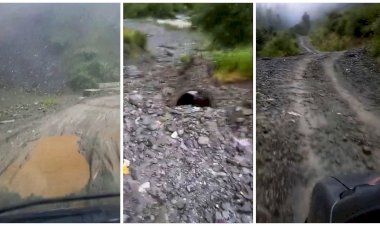THE PERILS OF PROGRESS : Lessons from the Mughal Road Landslide
Discover the environmental consequences of development on the Mughal Road and the importance of sustainable practices. Learn about the risks of landslides, flash floods, and ecological imbalances, and explore solutions like reforestation, slope stabilization, and the construction of a tunnel to mitigate these hazards. Find out how responsible development can ensure a harmonious coexistence with nature.

Development never occurs in isolation; instead, it often brings forth destructive side effects. Whether it is the creation of concrete jungles or the construction of roads, human interventions in nature have disrupted the delicate ecological balance, leading to nature’s retaliation.
Recent heavy rainfall and subsequent landslides on the historic Mughal Road have not only inconvenienced commuters but also prompted us to reflect on the underlying causes and consequences. Development, while often bringing progress, can also have destructive side effects.
The Mughal Road, originally built to connect the Kashmir region with Jammu via the Peer Panjal Range, offers a breathtaking pathway through beautiful mountains, rivers, and green landscapes that can easily captivate anyone's heart. The road, which reaches an elevation of approximately 11,000 feet above sea level at Pir ki Gali, has become a captivating destination for tourists from both regions. Vast meadows, adorned with snow-capped mountains and accompanied by refreshing breezes, transport travelers from the hustle and limited natural resources of urban areas to a whole new world. Over the years, efforts have been made to develop and upgrade this road to improve connectivity, trade, and tourism in the region. However, these developments and progress can come with unforeseen consequences. Thousands of trees had to be sacrificed to construct this 84 km road, but its compensation through planting more trees is still pending. The amount of time it will take is uncertain. However, we have already cut down the trees to build the road, disregarding the fact that these trees maintained our ecological balance. We too didn't leave any stone unturned in disrupting it.
It has exposed us to the risks of landslides, flash floods, and ecological imbalances. The recent landslide near Ratta Chamb serves as a stark reminder of the destruction that can result from human intervention in nature. Mechanized cutting of mountains to construct roads may bring convenience, but it comes at the expense of the delicate ecological balance. The Mughal Road, with its more than 38 landslide-prone areas, exemplifies the challenges faced when attempting to tame nature for the sake of progress.
Landslides are a natural phenomenon, but human activities such as road construction and deforestation can exacerbate their occurrence. The destabilization of slopes due to excavation weakens the natural structure of the mountains, making them more susceptible to landslides. Additionally, the removal of vegetation through deforestation removes an essential natural barrier that helps retain soil and stabilize slopes. These human-induced changes disrupt the ecological equilibrium, leading to adverse consequences for both the environment and human settlements.
It is crucial for us to recognize the long-term impact of our actions and adopt sustainable development practices. Balancing progress with environmental preservation is a challenging but essential task. When planning infrastructure projects, we must take into account the ecological sensitivity of the region and employ measures to mitigate potential hazards. This includes conducting thorough geological surveys, implementing slope stabilization techniques, and promoting reforestation efforts.
One of the most effective ways to mitigate the environmental damage caused by the construction of the Mughal Road is through reforestation, vegetation management, and ecological regeneration. By replanting trees and nurturing vegetation in the affected areas, we can stabilize the slopes and reduce the risk of future landslides. The roots of plants and trees play a vital role in binding the soil together, preventing erosion, and absorbing excess rainfall, thereby mitigating the chances of landslides and flash floods.
In the case of the Mughal Road, it is important that authorities closely monitor landslide-prone areas and take prompt action to reinforce slopes, divert water channels, and implement early warning systems. Simultaneously, efforts should be made to restore the natural vegetation cover and engage local communities in conservation initiatives.
The construction of the tunnel through the Pir Panjal, from Chatta Pani to Zanjijar, as previously proposed, needs to be initiated immediately. This project will effectively mitigate the risks associated with landslides and other potential hazards. Nitin Gadkari, the Minister of Road and Transport, Government of India, has recently expressed his keenness for the construction of the tunnel. While the exact timeline for its completion remains uncertain, we anticipate its construction in the near future. The tunnel's construction will not only enhance travel convenience but also contribute to the reduction of ecological imbalances.
By recognizing the risks associated with development and actively pursuing sustainable solutions, we can strike a balance between progress and environmental well-being. The Mughal Road landslides should serve as a wake-up call, reminding us of the fragility of our ecosystems and the need to prioritize nature while pursuing our ambitions. Only by embracing responsible development practices can we ensure a harmonious coexistence with the natural world for generations to come.
Ayaz Mughal can reached at WA +91 9858460733 and Email: editorkaangri@gmail.com










